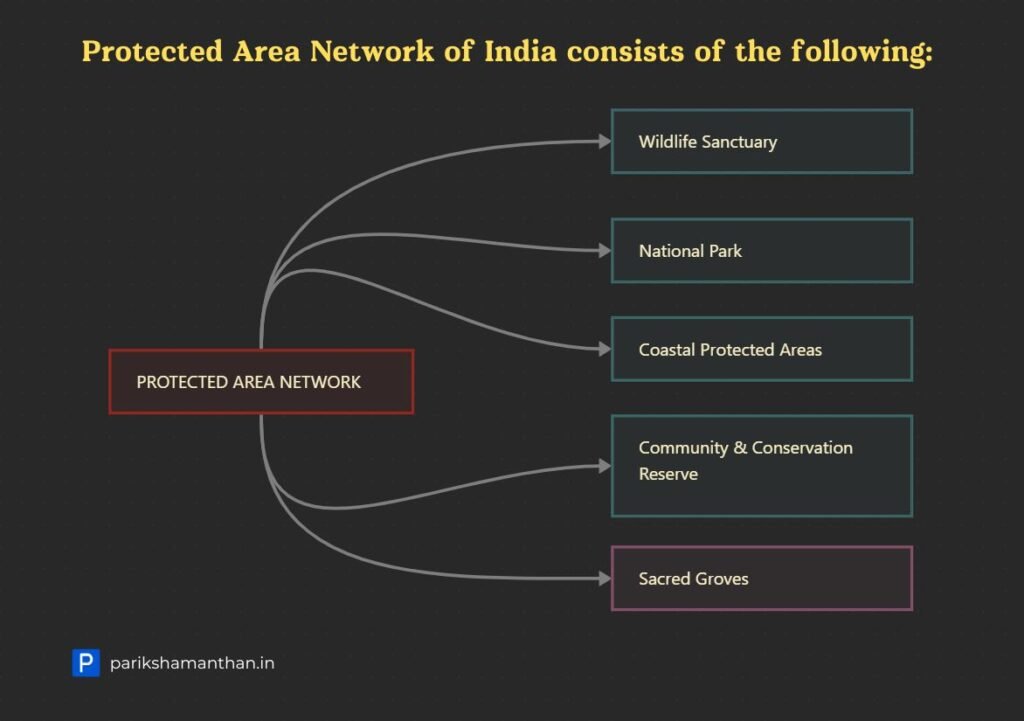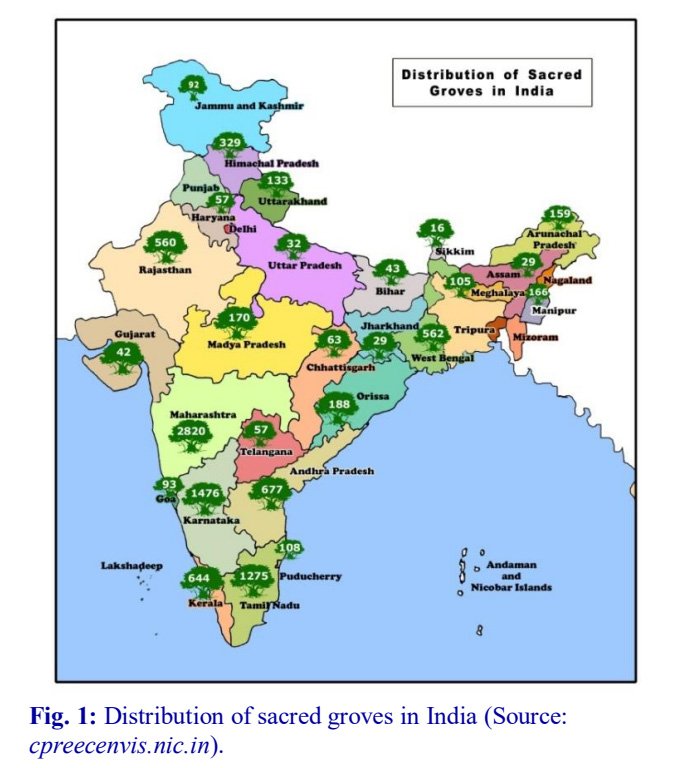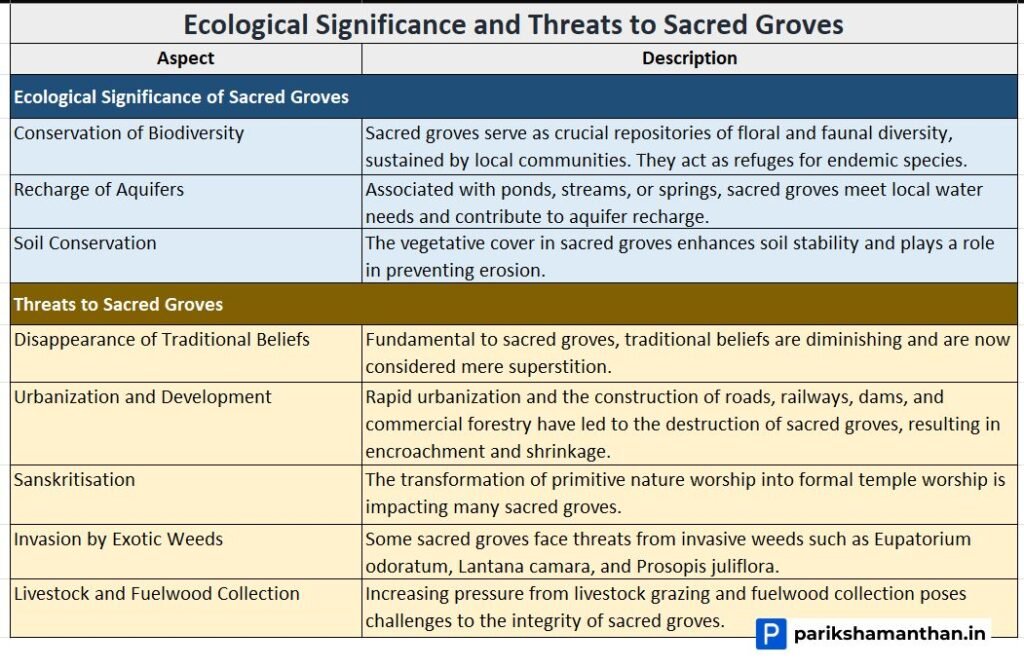Sacred groves in India are areas of natural vegetation, patches of forests dedicated to local deities, protected by communities due to religious beliefs. These groves harbor rich biodiversity, preserving endemic species and contributing to aquifer recharge. Threatened by urbanization and changing beliefs, their conservation is crucial for ecological balance and cultural heritage. Sacred groves in India are found in especially along the Western Ghats (Karnataka), Maharashtra, Rajasthan, Meghalaya and Madhya Pradesh.
Table of Contents
Define Sacred Groves (SG):
- Sacred groves are areas of natural vegetation, patches of forests ranging from small clusters to extensive forests, dedicated to local folk deities.
- Local communities safeguard these groves due to deep-rooted religious beliefs and traditional rituals passed down through generations.
- The sanctity level of these groves varies; some prohibit any disturbance, even touching dry foliage, to avoid displeasing local deities and invoking negative consequences.
- SG are notified under Wild Life (Protection), Amendment Act, 2002.
- SG are typically considered a form of in-situ conservation. In-situ conservation involves the conservation of species and ecosystems in their natural habitats. [ Read More: Which one of the following is not a site for in-situ method of conservation of flora? ]
- People fear that disturbing these sites may lead to diseases, natural disasters, or crop failures, varying across tribes. For instance, the Garo and Khasi tribes in Northeast India strictly forbid any interference.
- While some groves allow collection of deadwood, live trees or branches are never cut. The Gonds in central India, for example, prohibit tree cutting but permit the use of fallen parts.
- 5 examples of sacred groves in india:
- (a) Kalubai Sacred Grove in Pune, Maharashtra;
- (b) Garhwal Himalayas, Uttarakhand;
- (c) Khasi and Jaintia Hills (Meghalaya);
- (d) Aravali Hills (Rajasthan);
- (e) Western Ghats (Karnataka and Maharashtra);
- (f) Chanda and Bastar (Madhya Pradesh), and
- (g) Khecheopalri Lake (Sikkim).
Local Names or Meaning of Sacred Groves:
- Sacred groves meaning in malayalam : Kaavu, (ചെറുവനം) cheruvanam.
- Sacred groves meaning in telugu : ಪವಿತ್ರ ತೋಪು (Pavitra tōpu).
- Sacred groves meaning in Tamil : Koyil kaadu
- Sacred groves meaning in Rajasthan : Sacred groves are found all over Rajasthan and are called by various names such as Vani in Mewar, Kenkri in Ajmer, Oran in Jodhpur, Bikaner and Jaisalmer, Shamlat deh and Devbani in Alwar.
- Sacred groves meaning in Karnataka : Devarakaadu (sacred grove, ‘forest of the gods’). The Devarakadu is also called Rachammana kadu.
- Sacred groves meaning in Goa : In Goa, sacred groves are known by various names such as Devrai, Devran or Pann.
- Sacred groves meaning in Madhya Pradesh : Sernas
- Sacred groves meaning in Maharashtra: The sacred groves in the western part of Maharashtra are called Devrai or Devrahati, whereas in the eastern part the Madiya tribals call it Devgudi.

Classification of Sacred Groves (SG):
- Local Village Sacred Groves: Managed collectively by the entire village, accommodating various tribal communities and ethnic groups.
- Regional Sacred Groves: Administered by a temple trust, attracting visitors from multiple districts (e.g., Sabarimala in Alappuzha district, Kerala).
- Pan-Indian Sacred Groves: Extensive groves overseen by a temple trust, drawing worshippers nationwide (e.g., Garhwal Himalayas).
- Abode of Ancestral Spirits: Dual purpose as both a burial ground and a site for deity and ancestor worship.
Distribution of Sacred Groves in India:
- SG are widespread throughout India. Sacred groves are useful in conserving rare and threatened species.
- SG in India are found in especially along the Western Ghats in Maharashtra and Karnataka.
- Highest number of SG in india are in Maharashtra, the number is 1600 according to Deshmukh et al. (1998)
- These groves, often on tribal land, serve as havens for preserving many indigenous plant and animal species, protected from government intervention.
- Deforestation is strictly prohibited in these areas.
Sacred Groves in India map:

List of Sacred Groves in India:
Table 1: State-wise list of Sacred Groves in India
| S. No. | Location | No. of SG | Districts | Source |
|---|---|---|---|---|
| 1. | Andhra Pradesh | 677 | 13 | WWF, Andhra Pradesh (1996) |
| 2. | Arunachal Pradesh | 58 | 2 | Chatterjee et al. (2000) |
| 3. | Arunachal Pradesh | 101 | 4 | Khan (2007) |
| 4. | Assam | 17 | Karbi Anglong Community Resource Management Society | |
| 5. | Assam | 12 | 1 | Pramod Medhi and Sachin Kumar Borthakur (2013) |
| 6. | Bihar | 43 | 2 | Ranwa et al. (1998) and Gokhale (2002) |
| 7. | Chhattisgarh | 6 | 2 | Patnaik and Pandey (2014) |
| 8. | Chhattisgarh | 57 | – | Rahangdale et al. (2014) |
| 9. | Goa | 93 | – | Rajendra Kerkar (2010) |
| 10. | Gujarat | 6 | 1 | Patel and Patel (2012) |
| 11. | Gujarat | 4 | 1 | Maru and Patel (2013) |
| 12. | Gujarat | 5 | 1 | Patel and Patel (2013) |
| 13. | Gujarat | 6 | 1 | Patel Hitesh and Patel (2013) |
| 14. | Gujarat | 18 | 1 | Community conserved areas, (Gujarat), Kalpavriksh, Pune (2004). |
| 15. | Gujarat | 1 | 1 | Nimisha et al. (2013) |
| 16. | Gujarat | 2 | 1 | Patel et al. (2014) |
| 17. | Jammu and Kashmir | 16 | – | Gupta and Sharma (2013) |
| 18. | Jammu and Kashmir | 60 | – | Priya and Sharma (2014) |
| 19. | Jammu and Kashmir | 16 | – | Sharma and Devi (2014) |
| 20. | Jharkhand | 29 | 1 | Mahato (2012) |
| 21. | Karnataka | 1476 | – | Chandran and Gadgil (1998) |
| 22. | Kerala | 644 | Induchoodan, 1996 | |
| 23. | Kerala | 452 | 13 | http://www.forest.kerala.gov.in/ |
| 24. | Haryana | 248 | – | NAEB (1995) |
| 25. | Himachal Pradesh | 329 | – | Sacred Groves of Himachal Pradesh, Down to Earth, 31 December, 2003 |
| 26. | Madhya Pradesh | 23 | – | Kala (2011) |
| 27. | Madhya Pradesh | 77 | – | Shrivastava et al. (2011) |
| 28. | Madhya Pradesh | 49 | – | Masih and Homkar (2009) |
| 29. | Madhya Pradesh | 20 | 10 | Rajiv Rai (2014) |
| 30. | Maharashtra | 1600 | – | Deshmukh et al. (1998) |
| 31. | Maharashtra | 250 | 1 | Godbole et al., 1998 |
| 32. | Maharashtra | 483 | 10 | Gadgil and Vartak (1981b) |
| 33. | Manipur | 166 | 4 | Khumbongmayum, et al. (2004) |
| 34. | Manipur | 365 | – | Devi (2000) |
| 35. | Meghalaya | 105 | 6 | Tiwari et al. (1999) |
| 36. | Odisha | 169 | – | Malhotra et al. (1998) |
| 37. | Odisha | 6 | – | Debabrata et al. (2014) |
| 38. | Odisha | 13 | – | Mohanta and Adhikari (2012) |
| 39. | Puducherry | 108 | – | Dr. V.Krishnan, Plant Biodiversity, Bio-cultural Perspectives of Sacred Groves of Pondicherry and its environs |
| 40. | Rajasthan | 570 | 13 | Aman Singh, Krishi Avam Paristhitiki Vikas Sansthan (KRAPAVIS) |
| 41. | Sikkim | 16 | – | ENVIS Newsletter, The Forest, Environment & Wildlife Managemnt, Government of Sikkim (2011) |
| 42. | Tamil Nadu | 1275 | 31 | Amirthalingam (2012) |
| 43. | Telangana | 57 | 10 | WWF, Andhra Pradesh (1996) |
| 44. | Uttarakhand | 4 | 1 | Dhaila-Adhikari and Adhikari (2007) |
| 45. | Uttarakhand | 16 | 1 | Dr. S.S. Samant, Govind Ballabh Pant Institute of Himalayan Environment and Development, GBPIHED, Almora |
| 47. | Uttarakhand | 3 | 1 | CCA (ed.) Neema Pathak, Kalpavriksh (2009) |
| 48. | Uttarakhand | 102 | – | Gokhala and Pala (2011) |
| 49. | Uttarakhand | 7 | – | Sing et al. (2014) |
| 50. | Uttar Pradesh | 32 | – | Singh (2011) |
| 51. | West Bengal | 46 | – | Ranwa et al. (2002) |
| 52. | West Bengal | 20 | – | Pandit and Bhakat (2006) |
| 53. | West Bengal | 3 | – | Bhakat and Sen (2008) |
| 54. | West Bengal | 57 | – | Dandapat and Mishra (2014) |
| 55. | West Bengal | 190 | – | Deb and Malhotra (2001) |
| 56. | West Bengal | 670 | 5 | Deb et al. (1997) |
What is the role of Sacred Groves in Biodiversity Conservation:
Ecological Significance of Sacred Groves (SG):
- Conservation of Biodiversity: SG are vital hubs of floral and faunal diversity, conserved sustainably by local communities. They often harbor endemic species, acting as the last refuge in the region.
- Recharge of Aquifers: Associated with ponds, streams, or springs, SG fulfill local water needs. The vegetative cover aids in aquifer recharge.
- Soil Conservation: Vegetation in sacred groves enhances soil stability and prevents erosion.
Threats to Sacred Groves (SG):
- The threats vary from one region to the other and even from one grove to the other. But the most common threats identified are as follows:
- Disappearance of Traditional Belief Systems: Fundamental to sacred groves, traditional beliefs are diminishing, considered mere superstition.
- Urbanization and Developmental Interventions: Rapid urbanization, roads, railways, dams, and commercial forestry have destroyed many SG, leading to encroachment and shrinkage.
- Sanskritisation: Primitive nature worship transforms into formal temple worship, impacting many groves.
- Invasion by Exotic Weeds: Threats from weeds like Eupatorium odoratum, Lantana camara, and Prosopis juliflora.
- Livestock and Fuelwood Collection Pressure: Increasing livestock and fuelwood collection pose challenges to sacred groves.
Ecological Significance and Threats to Sacred Groves (SG) in table form:

| Aspect | Description |
|---|---|
| Ecological Significance of Sacred Groves | |
| Conservation of Biodiversity | SG serve as crucial repositories of floral and faunal diversity, sustained by local communities. They act as refuges for endemic species. |
| Recharge of Aquifers | Associated with ponds, streams, or springs, SG meet local water needs and contribute to aquifer recharge. |
| Soil Conservation | The vegetative cover in SG enhances soil stability and plays a role in preventing erosion. |
| Threats to Sacred Groves | |
| Disappearance of Traditional Beliefs | Fundamental to SG, traditional beliefs are diminishing and are now considered mere superstition. |
| Urbanization and Development | Rapid urbanization and the construction of roads, railways, dams, and commercial forestry have led to the destruction of SG, resulting in encroachment and shrinkage. |
| Sanskritisation | The transformation of primitive nature worship into formal temple worship is impacting many sacred groves. |
| Invasion by Exotic Weeds | Some SG face threats from invasive weeds such as Eupatorium odoratum, Lantana camara, and Prosopis juliflora. |
| Livestock and Fuelwood Collection | Increasing pressure from livestock grazing and fuelwood collection poses challenges to the integrity of SG. |
Enjoy Reading!







